Sushi
Sushi (すし, 寿司, 鮨, 鮓, pronounced [sɯɕiꜜ] or [sɯꜜɕi]) is a Japanese dish of prepared vinegared rice (鮨飯, sushi-meshi), usually with some sugar and salt, accompanied by a variety of ingredients (ねた, neta), such as seafood, often raw, and vegetables. Styles of sushi and its presentation vary widely, but the one key ingredient is "sushi rice", also referred to as shari (しゃり), or sumeshi (酢飯).[1]
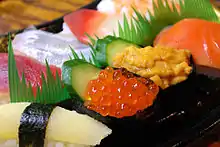 | |
| Place of origin | Japan |
|---|---|
| Main ingredients |
|
The inventor of modern sushi is believed to be Hanaya Yohei, who invented nigiri-zushi, a type of sushi most known today, in which seafood is placed on hand-pressed vinegared rice, around 1824 in the Edo period (1603–1867). It was the fast food of the chōnin class in the Edo period.[2][3][4]
Sushi is traditionally made with medium-grain white rice, though it can be prepared with brown rice or short-grain rice. It is very often prepared with seafood, such as squid, eel, yellowtail, salmon, tuna or imitation crab meat. Many types of sushi are vegetarian. It is often served with pickled ginger (gari), wasabi, and soy sauce. Daikon radish or pickled daikon (takuan) are popular garnishes for the dish.
Sushi is sometimes confused with sashimi, a similar dish in Japanese cuisine that consists of thinly sliced raw fish or occasionally meat.[5]
History

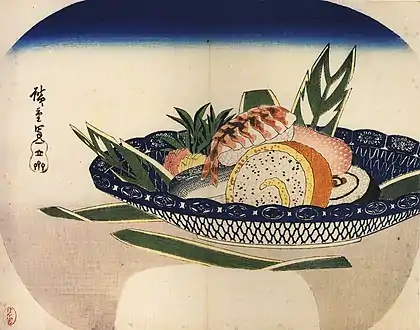
A dish known as narezushi (馴れ寿司, 熟寿司, "salted fish"), stored in fermented rice for possibly months at a time, has been cited as one of the early influences for the Japanese practice of applying rice on raw fish.[6] The fish was fermented with rice vinegar, salt and rice, after which the rice was discarded. The process can be traced back to the early domestication of rice in the Neolithic cultures of China. Fermentation methods following similar logic in other Asian rice cultures include prahok (ប្រហុក), pla ra (ปลาร้า), burong isda, sikhae (식해), and amazake (甘酒).[6][7]
The lacto-fermentation of the rice prevents the fish from spoiling. When wet-field rice cultivation was introduced during the Yayoi period, lakes and rivers would flood during the rainy season and fish would get caught in the rice paddy fields. Pickling was a way to preserve the excess fish and guarantee food for the next months, and narezushi became an important source of protein for Japanese consumers. The term sushi literally means "sour-tasting", as the overall dish has a sour and umami or savoury taste. The term comes from an antiquated し shi terminal-form conjugation, no longer used in other contexts, of the adjectival verb sui (酸い, "to be sour"),[8] resulting in the term sushi (酸し).[9] Narezushi still exists as a regional specialty, notably as funa-zushi from Shiga Prefecture.[10] Vinegar began to be added to the preparation of narezushi in the Muromachi period (1336–1573) for the sake of enhancing both taste and preservation. In addition to increasing the sourness of the rice, the vinegar significantly increased the dish's longevity, causing the fermentation process to be shortened and eventually abandoned. The primitive sushi would be further developed in Osaka, where over several centuries it became oshi-zushi or hako-zushi; in this preparation, the seafood and rice were pressed into shape with wooden (typically bamboo) molds.
It was not until the Edo period (1603–1868) that fresh fish was served over vinegared rice and nori. The particular style of today's nigirizushi became popular in Edo (contemporary Tokyo) in the 1820s or 1830s. One common story of nigirizushi's origins is of the chef Hanaya Yohei (1799–1858), who invented or perfected the technique in 1824 at his shop in Ryōgoku.[10] The dish was originally termed Edomae zushi as it used freshly caught fish from the Edo-mae (Edo or Tokyo Bay); the term Edomae nigirizushi is still used today as a by-word for quality sushi, regardless of its ingredients' origins.[11][12]
The earliest written mention of sushi in English described in the Oxford English Dictionary is in an 1893 book, A Japanese Interior, where it mentions sushi as "a roll of cold rice with fish, sea-weed, or some other flavoring".[13][14] There is an earlier mention of sushi in James Hepburn's Japanese–English dictionary from 1873,[15] and an 1879 article on Japanese cookery in the journal Notes and Queries.[16]
Types
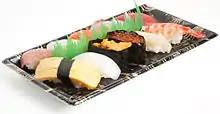
The common ingredient in all types of sushi is vinegared sushi rice. Fillings, toppings, condiments, and preparation vary widely.[17]
Due to rendaku consonant mutation, sushi is pronounced with zu instead of su when a prefix is attached, as in nigirizushi.
Chirashizushi
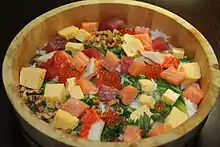
Chirashizushi (ちらし寿司, "scattered sushi", also referred to as barazushi) serves the rice in a bowl and tops it with a variety of raw fish and vegetable garnishes. It is popular because it is filling, fast and easy to make.[18] It is eaten annually on Hinamatsuri in March and Kodomonohi in May.
- Edomae chirashizushi (Edo-style scattered sushi) is served with uncooked ingredients in an artful arrangement.
- Gomokuzushi (Kansai-style sushi) consists of cooked or uncooked ingredients mixed in the body of rice.
- Sake-zushi (Kyushu-style sushi) uses rice wine over vinegar in preparing the rice, and is topped with shrimp, sea bream, octopus, shiitake mushrooms, bamboo shoots and shredded omelette.
Inarizushi
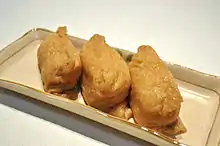
稲荷寿司 (Inarizushi) is a pouch of fried tofu typically filled with sushi rice alone. Tales tell that inarizushi is named after the Shinto god Inari. Foxes, messengers of Inari, are believed to have a fondness for fried tofu, and an inarizushi roll has pointed corners that resemble fox ears.[19]
Regional variations include pouches made of a thin omelette (帛紗寿司, fukusa-zushi, or 茶巾寿司, chakin-zushi) instead of tofu. It should not be confused with inari maki, which is a roll filled with flavored fried tofu.
Cone sushi is a variant of inarizushi originating in Hawaii that may include green beans, carrots, or gobo along with rice, wrapped in a triangular abura-age piece. It is often sold in okazu-ya (Japanese delis) and as a component of bento boxes.[20][21][22][23]
Makizushi
Makizushi (巻き寿司, "rolled sushi"), norimaki (海苔巻き, "nori roll", used generically for other dishes as well) or makimono (巻物, "variety of rolls") is a cylindrical piece formed with the help of a mat known as a makisu (巻き簾). Makizushi is generally wrapped in nori (seaweed), but is occasionally wrapped in a thin omelette, soy paper, cucumber, or shiso (perilla) leaves. Makizushi is often cut into six or eight pieces, which constitutes a single roll order. Short-grain white rice is usually used, although short-grain brown rice, like olive oil on nori, is now becoming more widespread among the health-conscious. Rarely, sweet rice is mixed in makizushi rice.
Nowadays, the rice in makizushi can be many kinds of black rice, boiled rice and cereals. Besides the common ingredients listed above, some varieties may include cheese, spicy cooked squid, yakiniku, kamaboko, lunch meat, sausage, bacon or spicy tuna. The nori may be brushed with sesame oil or sprinkled with sesame seeds. In a variation, sliced pieces of makizushi may be lightly fried with egg coating.
Below are some common types of makizushi, but many other kinds exist.
- Futomaki (太巻, "thick, large, or fat rolls") is a large, cylindrical style of sushi, usually with nori on the outside.[24] A typical futomaki is five to six centimetres (2 to 2+1⁄2 in) in diameter.[25] They are often made with two, three, or more fillings that are chosen for their complementary tastes and colors. Futomaki are often vegetarian, and may utilize strips of cucumber, kampyō gourd, takenoko (bamboo shoots), or lotus root. Strips of tamagoyaki omelette, tiny fish roe, chopped tuna, and oboro whitefish flakes are typical non-vegetarian fillings.[24] Traditionally, the vinegared rice is lightly seasoned with salt and sugar. Popular proteins are fish cakes, imitation crab meat, egg, tuna, or shrimp. Vegetables usually include cucumbers, lettuces, and takuan (沢庵, pickled radish).
- Tamago makizushi (玉子巻き寿司) is makizushi is rolled out by a thin egg.
- Tempura makizushi (天ぷら 巻き寿司) or agezushi (揚げ寿司ロール) is a fried version of the dish.
- During the evening of the festival of Setsubun (節分), it is traditional in the Kansai region to eat a particular kind of futomaki in its uncut cylindrical form, called ehōmaki (惠方巻, "lucky direction roll").[26] By 2000 the custom had spread to all of Japan.[27] Ehōmaki is roll composed of seven ingredients considered to be lucky. The typical ingredients include kanpyō, egg, eel, and shiitake. Ehōmaki often include other ingredients too. People usually eat the ehōmaki while facing the direction considered to be auspicious that year.[28]
- Hosomaki (細巻, "thin rolls") is a type of small cylindrical sushi, with nori on the outside. A typical hosomaki has a diameter of about 2.5 centimetres (1 in).[25] They generally contain only one filling, often tuna, cucumber, kanpyō, nattō, umeboshi paste, and squid with shiso (Japanese herb).
- Kappamaki (河童巻) is a kind of hosomaki filled with cucumber. It is named after the Japanese legendary water imp, fond of cucumbers, called the kappa. Traditionally, kappamaki is consumed to clear the palate between eating raw fish and other kinds of food, so that the flavors of the fish are distinct from the tastes of other foods.
- Tekkamaki (鉄火巻) is a kind of hosomaki filled with raw tuna. Although it is believed that the word tekka, meaning "red hot iron", alludes to the color of the tuna flesh or salmon flesh, it actually originated as a quick snack to eat in gambling dens called tekkaba (鉄火場), much like the origins of the sandwich.[29][30]
- Negitoromaki (ねぎとろ巻) is a kind of hosomaki filled with negitoro, aka scallion (negi) and chopped tuna (toro). Fatty tuna is often used in this style.
- Tsunamayomaki (ツナマヨ巻) is a kind of hosomaki filled with canned tuna tossed with mayonnaise.
- Temaki (手巻, "hand roll") is a large cone-shaped style of sushi with nori on the outside and the ingredients spilling out the wide end. A typical temaki is about 10 centimetres (4 in) long, and is eaten with the fingers because it is too awkward to pick it up with chopsticks. For optimal taste and texture, temaki must be eaten quickly after being made because the nori cone soon absorbs moisture from the filling and loses its crispness, making it somewhat difficult to bite through. For this reason, the nori in pre-made or take-out temaki is sealed in plastic film which is removed immediately before eating.[31]
 Makizushi topped with tobiko
Makizushi topped with tobiko Makizushi in preparation
Makizushi in preparation Futomaki
Futomaki Kappamaki
Kappamaki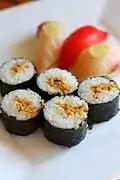 Nattōmaki
Nattōmaki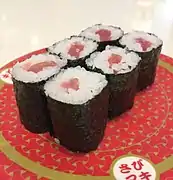 Tekkamaki
Tekkamaki Ehōmaki
Ehōmaki
Modern narezushi
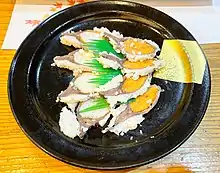
Narezushi (熟れ寿司, "matured sushi") is a traditional form of fermented sushi. Skinned and gutted fish are stuffed with salt, placed in a wooden barrel, doused with salt again, then weighed down with a heavy tsukemonoishi (pickling stone). As days pass, water seeps out and is removed. After six months, this sushi can be eaten, remaining edible for another six months or more.[32]
The most famous variety of narezushi are the ones offered as a specialty dish of Shiga Prefecture,[33] particularly the funa-zushi made from fish of the crucian carp genus, the authentic version of which calls for the use of nigorobuna, a particular locally differentiated variety of wild goldfish endemic to Lake Biwa.[34]
Nigirizushi
.jpg.webp)
.jpg.webp)
Nigirizushi (握り寿司, "hand-pressed sushi") consists of an oblong mound of sushi rice that the chef presses between the palms of the hands to form an oval-shaped ball, and a topping (the neta) draped over the ball. It is usually served with a bit of wasabi; toppings are typically fish such as salmon, tuna or other seafood. Certain toppings are typically bound to the rice with a thin strip of nori, most commonly octopus (tako), freshwater eel (unagi), sea eel (anago), squid (ika), and sweet egg (tamago). One order of a given type of fish typically results in two pieces, while a sushi set (sampler dish) may contain only one piece of each topping.
Gunkanmaki (軍艦巻, "warship roll") is a special type of nigirizushi: an oval, hand-formed clump of sushi rice that has a strip of nori wrapped around its perimeter to form a vessel that is filled with some soft, loose or fine-chopped ingredient that requires the confinement of nori such as roe, nattō, oysters, uni (sea urchin roe), sweetcorn with mayonnaise, scallops, and quail eggs. Gunkan-maki was invented at the Ginza Kyubey restaurant in 1941; its invention significantly expanded the repertoire of soft toppings used in sushi.[35][36]
Temarizushi (手まり寿司, "ball sushi") is a style of sushi made by pressing rice and fish into a ball-shaped form by hand using a plastic wrap.
Oshizushi
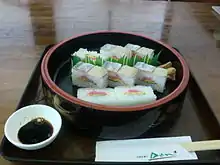
.jpg.webp)
Oshizushi (押し寿司, "pressed sushi"), also known as hako-zushi (箱寿司, "box sushi"), is a pressed sushi from the Kansai region, a favorite and specialty of Osaka. A block-shaped piece is formed using a wooden mold, called an oshibako. The chef lines the bottom of the oshibako with the toppings, covers them with sushi rice, and then presses the lid of the mold down to create a compact, rectilinear block. The block is removed from the mold and then cut into bite-sized pieces. Particularly famous is battera (バッテラ, pressed mackerel sushi) or saba zushi (鯖寿司).[37] In oshizushi, all the ingredients are either cooked or cured and raw fish is never used.[38]
Oshizushi wrapped in persimmon leaves, a specialty of Nara, is known as kakinohazushi (柿の葉寿司).
Western-style sushi
The increasing popularity of sushi around the world has resulted in variations typically found in the Western world, but rarely in Japan. A notable exception to this is the use of salmon. Historically, the Japanese have eaten salmon since prehistory; however, caught salmon in nature often contains parasites and must be cooked or cured for its lean meat to be edible - therefore, unsuitable as raw meat. On the other side of the world, in the 1960s and 1970s, Norwegian entrepreneurs started experimenting with aquaculture farming. The big breakthrough was when they figured out how to raise salmon in net pens in the sea. Being farm raised, the Atlantic salmon reportedly showed advantages over the Pacific salmon, such as no parasites, easy animal capture and could be grown with higher fat content. With government subsidies and improved techniques, they were so successful in raising fatty and parasite-free salmon, they ended up with a surplus. The country of Norway has a small population and limited market, therefore they looked to other countries to export their salmon. The first Norwegian salmon was imported into Japan in 1980, accepted in the conventional way, for grilling, and not for sushi. Salmon had already been consumed in North America as an ingredient in sushi as early as the 1970s.[40][41][42] Salmon sushi did not become widely accepted in Japan until a successful marketing partnership in the late 1980s between a Norwegian businessman tasked with helping the Norwegian salmon industry and the Japanese food supplier Nichirei.[43][44][39]
Other sushi creations to suit the Western palate were initially fueled by the invention of the California roll (a norimaki with crab or imitation crab, cucumber, and avocado). A wide variety of popular rolls (norimaki and uramaki) have evolved since. 'Norway roll' is another variant of uramakizushi filled with tamago (omelette), imitation crab and cucumber, rolled with shiso leaf and nori, topped with slices of Norwegian salmon, garnished with lemon and mayonnaise.[45]
Uramaki
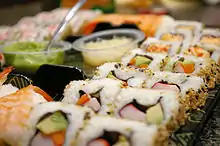
Uramaki (裏巻, "inside-out roll") is a medium-sized cylindrical style of sushi with two or more fillings, and was developed as a result of the creation of the California roll, as a method originally meant to hide the nori. Uramaki differs from other makimono because the rice is on the outside and the nori inside. The filling is in the center surrounded by nori, then a layer of rice, and optionally an outer coating of some other ingredients such as roe or toasted sesame seeds. It can be made with different fillings, such as tuna, crab meat, avocado, mayonnaise, cucumber or carrots.
Examples of variations include the rainbow roll (an inside-out topped with thinly sliced maguro, hamachi, ebi, sake and avocado) and the caterpillar roll (an inside-out topped with thinly sliced avocado). Also commonly found is the "rock and roll" (an inside-out roll with barbecued freshwater eel and avocado with toasted sesame seeds on the outside).
In Japan, uramaki is an uncommon type of makimono; because sushi is traditionally eaten by hand in Japan, the outer layer of rice can be quite difficult to handle with fingers.[46]
In Brazil, uramaki and other sushi pieces include cream cheese in their recipe. Uncommon for the traditional recipe, this is the most common type of ingredient used in preparation of sushi in the country. Temaki also often contains a large amount of cream cheese, and is extremely popular in restaurants.[47]
American-style makizushi

Futomaki is a more popular variation of sushi within the United States, and comes in variations that take their names from their places of origin. Other rolls may include a variety of ingredients, including chopped scallops, spicy tuna, beef or chicken teriyaki roll, okra, and assorted vegetables such as cucumber and avocado, and the tempura roll, where shrimp tempura is inside the roll or the entire roll is battered and fried tempura-style. In the Southern United States, many sushi restaurants prepare rolls using crawfish. Sometimes, rolls are made with brown rice or black rice, known as forbidden rice, which appear in Japanese cuisine as well.
Per Food and Drug Administration regulations, raw fish served in the United States must be frozen prior to serving in order to kill parasites.[48]
Since rolls are often made to order it is not unusual for the customer to specify the exact ingredients desired (e.g. salmon roll, cucumber roll, avocado roll, tuna roll, shrimp or tuna tempura roll, etc.). Though the menu names of dishes often vary by restaurant, some examples include:
| Sushi roll name | Definition |
|---|---|
| Alaskan roll | A variant of the California roll with smoked salmon on the inside, or layered on the outside.[49] |
| Boston roll | An uramaki California roll with poached shrimp instead of imitation crab.[50] |
| British Columbia roll | A roll containing grilled or barbecued salmon skin, cucumber, sweet sauce, sometimes with roe. Also sometimes referred to as salmon skin rolls outside of British Columbia, Canada.[51] |
| California roll | A roll consisting of avocado, kani kama (imitation crab/crab stick) (also can contain real crab in "premium" varieties), cucumber, and tobiko, often made as uramaki (with rice on the outside, nori on the inside).[52] |
| Dynamite roll | A roll including yellowtail (hamachi) or prawn tempura, and fillings such as bean sprouts, carrots, avocado, cucumber, chili, spicy mayonnaise, and roe.[53] |
| Hawaiian roll | A roll containing shōyu tuna (canned), tamago, kanpyō, kamaboko, and the distinctive red and green hana ebi (shrimp powder).[54] |
| Mango roll | A roll including fillings such as avocado, crab meat, tempura shrimp, mango slices, and topped off with a creamy mango paste.[55] |
| Michigan roll | A roll including fillings such as spicy tuna, smelt roe, spicy sauce, avocado, and sushi rice. Is a variation on spicy tuna roll.[56] |
| New Mexico roll | A roll originating in New Mexico; includes New Mexico green chile (sometimes tempura fried), teriyaki sauce, and rice.[57][58] Sometimes simply referred to as a "green chile (tempura) roll" within the state.[59][60] |
| Philadelphia roll | A roll consisting of raw or smoked salmon, cream cheese (the name refers to Philadelphia cream cheese), cucumber or avocado, or onion.[61] |
| Rainbow roll | A California uramaki roll with multiple types of fish (commonly yellowtail, tuna, salmon, snapper, white fish, eel, etc.) and avocado wrapped around it.[62] |
| Seattle roll | A roll consisting of cucumber, avocado, cream cheese and raw or smoked salmon.[63] |
| Spicy tuna roll | A roll including raw tuna mixed with sriracha mayonnaise. |
| Spider roll | A roll including fried soft-shell crab and other fillings such as cucumber, avocado, daikon sprouts or lettuce, roe, and sometimes spicy mayonnaise.[64] |
| Sushi burrito | A large, customizable roll offered in a number of "sushi burrito" restaurants in the United States.[65] |
Canada
Many of the styles seen in the United States are also seen in Canada, as well as their own. Doshi (a portmanteau of sushi and doughnut) is a doughnut shaped ball of rice on a deep fried crab or imitation crab cake topped with sushi ingredients.[66] Maki Poutine is similar to makizushi in style except it is topped with cheese curds and gravy and contains duck confit, more cheese curds, and sweet potato tempura.[67] Sushi cake is made of crab meat, avocado, shiitake mushroom, salmon, spicy tuna, and tobiko and served on sushi rice then torched with spicy mayo, BBQ sauce, balsamic reduction, and dotted with caper and garlic chips.[68] Sushi pizza is a deep fried rice or crab/imitation crab cake topped with mayo and various sushi ingredients.[69]
Mexico and the Western United States
Sinaloan sushi originated in Sinaloa, Mexico, and has been available in the Western United States since 2013.[70]
Sushi in Asia
South Korea
Gimbap, similar to makizushi, is a popular take-out food in South Korea.[71] It consists of gim (nori flavored with sesame oil and salt) rolled around rice and a variety of ingredients such as vegetables and meat.[72]
Ingredients
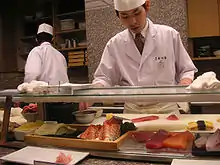
All sushi has a base of specially prepared rice, complemented with other ingredients. Traditional Japanese sushi consisting of rice flavored with vinegar sauce and various raw or cooked ingredients.
Sushi-meshi
Sushi-meshi (鮨飯) (also known as su-meshi (酢飯), shari (舎利), or gohan (ご飯)) is a preparation of white, short-grained, Japanese rice mixed with a dressing consisting of rice vinegar, sugar, salt, and occasionally kombu and sake. It has to be cooled to room temperature before being used for a filling in a sushi or else it will get too sticky while being seasoned. Traditionally, it is mixed with a hangiri (a round, flat-bottom wooden tub or barrel) and a shamoji (a wooden paddle).
Sushi rice is prepared with short-grain Japanese rice, which has a consistency that differs from long-grain strains such as those from India, Sri Lanka, Bangladesh, Thailand, and Vietnam. The essential quality is its stickiness or glutinousness, although the type of rice used for sushi is different from glutinous rice. Freshly harvested rice (shinmai) typically contains too much water, and requires extra time to drain the rice cooker after washing. In some fusion cuisine restaurants, short-grain brown rice and wild rice are also used.
There are regional variations in sushi rice and individual chefs have their individual methods. Most of the variations are in the rice vinegar dressing: the Kantō region (or East Japan) version of the dressing commonly uses more salt; in Kansai region (or West Japan), the dressing has more sugar.
Nori
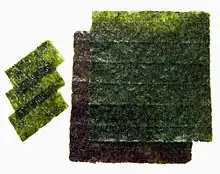
The dark green seaweed wrappers used in makimono are called nori (海苔). Nori is a type of algae, traditionally cultivated in the harbors of Japan. Originally, algae was scraped from dock pilings, rolled out into thin, edible sheets, and dried in the sun, in a process similar to making rice paper.[73] Today, the commercial product is farmed, processed, toasted, packaged, and sold in sheets.
The size of a nori sheet influences the size of makimono. A full-size sheet produces futomaki, and a half produces hosomaki and temaki. To produce gunkan and some other makimono, an appropriately-sized piece of nori is cut from a whole sheet.
Nori by itself is an edible snack and is available with salt or flavored with teriyaki sauce. The flavored variety, however, tends to be of lesser quality and is not suitable for sushi.
When making fukusazushi, a paper-thin omelette may replace a sheet of nori as the wrapping. The omelette is traditionally made on a rectangular omelette pan, known as a makiyakinabe, and used to form the pouch for the rice and fillings.[74]
Gu
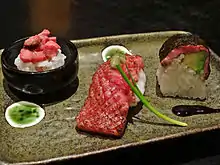
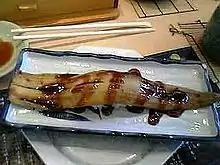

The ingredients used inside sushi are called gu, and are, typically, varieties of fish.[75] For culinary, sanitary, and aesthetic reasons, the minimum quality and freshness of fish to be eaten raw must be superior to that of fish which is to be cooked. Sushi chefs are trained to recognize important attributes, including smell, color, firmness, and freedom from parasites that may go undetected in commercial inspection. Commonly used fish are tuna (maguro, shiro-maguro), Japanese amberjack, yellowtail (hamachi), snapper (kurodai), mackerel (saba), and salmon (sake). The most valued sushi ingredient is toro, the fatty cut of the fish.[76] This comes in a variety of ōtoro (often from the bluefin species of tuna) and chūtoro, meaning "middle toro", implying that it is halfway into the fattiness between toro and the regular cut. Aburi style refers to nigiri sushi where the fish is partially grilled (topside) and partially raw. Most nigiri sushi will have completely raw toppings, called neta.[75]
Other seafoods such as squid (ika), eel (anago and unagi), pike conger (hamo), octopus (tako), shrimp (ebi and amaebi), clam (mirugai, aoyagi and akagai), fish roe (ikura, masago, kazunoko and tobiko), sea urchin (uni), crab (kani), and various kinds of shellfish (abalone, prawn, scallop) are the most popular seafoods in sushi. Oysters, however, are less common, as the taste is thought to not go well with the rice. Kani kama, or imitation crab stick, is commonly substituted for real crab, most notably in California rolls.[77]
Pickled daikon radish (takuan) in shinko maki, pickled vegetables (tsukemono), fermented soybeans (nattō) in nattō maki, avocado, cucumber in kappa maki, asparagus,[78] yam, pickled ume (umeboshi), gourd (kanpyō), burdock (gobo), and sweet corn (sometimes mixed with mayonnaise) are plant products used in sushi.
Tofu, eggs (in the form of slightly sweet, layered omelette called tamagoyaki), and raw quail eggs (as a gunkan-maki topping) are also common.
Condiments
Sushi is commonly eaten with condiments. Sushi may be dipped in shōyu (soy sauce), and is usually flavored with wasabi, a piquant paste made from the grated stem of the Wasabia japonica plant. Japanese-style mayonnaise is a common condiment in Japan on salmon, pork and other sushi cuts.
The traditional grating tool for wasabi is a sharkskin grater or samegawa oroshi. An imitation wasabi (seiyo-wasabi), made from horseradish, mustard powder and green dye is common. It is found at lower-end kaiten-zushi restaurants, in bento box sushi and at most restaurants outside Japan. If manufactured in Japan, it may be labelled "Japanese Horseradish".[79] The spicy compound in both true and imitation wasabi is allyl isothiocyanate, which has well-known anti-microbial properties. However, true wasabi may contain some other antimicrobial as well.[80]
Gari (sweet, pickled ginger) is eaten in between sushi courses to both cleanse the palate and aid in digestion. In Japan, green tea (ocha) is invariably served together with sushi. Better sushi restaurants often use a distinctive premium tea known as mecha. In sushi vocabulary, green tea is known as agari.
Sushi may be garnished with gobo, grated daikon, thinly-sliced vegetables, carrots, radishes and cucumbers that have been shaped to look like flowers, real flowers, or seaweed salad.
When closely arranged on a tray, different pieces are often separated by green strips called baran or kiri-zasa (切り笹). These dividers prevent the flavors of neighboring pieces of sushi from mixing and help to achieve an attractive presentation. Originally, these were cut leaves from the Aspidistra elatior (葉蘭, haran) and Sasa veitchii (熊笹, kuma-zasa) plants, respectively. Using actual leaves had the added benefit of releasing antimicrobial phytoncides when cut thereby extending the limited shelf life of the sushi.[81]
Sushi bento boxes are a staple of Japanese supermarkets and convenience stores. As these stores began rising in prominence in the 1960s, the labor-intensive cut leaves were increasingly replaced with green plastic in order to lower costs. This coincided with the increased prevalence of refrigeration which acted to extend the shelf life of sushi without the need for the cut leaves. Today the plastic strips are commonly used in sushi bento boxes and to a lesser degree in sushi presentations found in sushi bars and restaurants. In store-sold or to-go packages of sushi, the plastic leaf strips are often used to prevent the rolls from coming into early or unwanted contact with the ginger and wasabi included with the dish.[82]
Nutrition

The main ingredients of traditional Japanese sushi, raw fish and rice, are naturally low in fat, high in protein, carbohydrates (the rice only), vitamins, and minerals, as are gari and nori. Other vegetables wrapped within the sushi also offer various vitamins and minerals. Many of the seafood ingredients also contain omega-3 fatty acids, which have a variety of health benefits.[83] The omega-3 fatty acids found in fish has certain beneficial properties, especially on cardiovascular health, natural anti-inflammatory compounds, and play a role in brain function.[84]
Generally sushi is not a particularly fattening food. However, rice in sushi contains a fair amount of carbohydrates, plus the addition of other ingredients such as mayonnaise added into sushi rolls might increase the caloric content.[85] Sushi also has a relatively high sodium content, especially contributed from soy sauce seasoning.[84]
Health risks
Potential chemical and biological hazards in sushi include environmental contaminants, pathogens and toxins.
Large marine apex predators such as tuna (especially bluefin) can harbor high levels of methylmercury, one of many toxins of marine pollution. Frequent or significantly large consumption of methylmercury can lead to developmental defects when consumed by certain higher-risk groups, including women who are pregnant or may become pregnant, nursing mothers and young children.[86] A 2021 study in Catalonia, Spain reported that the estimated exposure to methylmercury in sushi consumption by adolescents exceeded the tolerable daily intake.[87]
A 2011 article reported approximately 18 million people infected with fish-borne flukes worldwide.[88] Such an infection can be dangerous for expecting mothers due to the health risks that medical interventions or treatment measures may pose on the developing fetus.[88] Parasitic infections can have a wide range of health impacts, including bowel obstruction, anemia, liver disease, and more.[88] The impact of these illnesses can pose some health concerns on the expecting mother and baby.[88]
Sashimi or other types of sushi containing raw fish present a risk of infection by three main types of parasites:
- Clonorchis sinensis, a fluke which can cause clonorchiasis[89]
- Anisakis, a roundworm which can cause anisakiasis[90]
- Diphyllobothrium, a tapeworm which can cause diphyllobothriasis[91]
For these reasons, EU regulations forbid the use of fresh raw fish. It must be frozen at temperatures below −20 °C (−4 °F) in all parts of the product for no less than 24 hours.[92] As such, a number of fishing boats, suppliers and end users flash freeze fish for sushi to temperatures as low as −60 °C (−76 °F).[93] As well as parasite destruction, super-freezing also prevents oxidation of the blood in tuna flesh, thus preventing the discoloration that happens at temperatures above −20 °C (−4 °F).[94]
Calls for stricter analysis and regulation of seafood include improved product description. A 2021 DNA study in Italy found 30%-40% of fish species in sushi incorrectly described.[95]
Some forms of sushi, notably those containing the fugu pufferfish and some kinds of shellfish, can cause severe poisoning if not prepared properly. Particularly, fugu consumption can be fatal. Fugu fish has a lethal dose of tetrodotoxin in its internal organs and, by law in many countries, must be prepared by a licensed fugu chef who has passed the prefectural examination in Japan.[96] The licensing examination process consists of a written test, a fish-identification test, and a practical test that involves preparing the fugu and separating out the poisonous organs. Only about 35 percent of the applicants pass.[97]
Sustainable sushi
Sustainable sushi is sushi made from fished or farmed sources that can be maintained or whose future production does not significantly jeopardize the ecosystems from which it is acquired. Concerns over the sustainability of sushi ingredients arise from greater concerns over environmental, economic and social stability and human health.
Presentation
.JPG.webp)
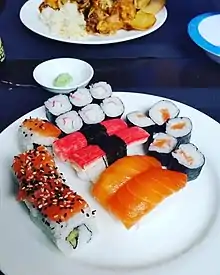
Traditionally, sushi is served on minimalist Japanese-style, geometric, mono- or duo-tone wood or lacquer plates, in keeping with the aesthetic qualities of this cuisine.
Many sushi restaurants offer fixed-price sets, selected by the chef from the catch of the day. These are often graded as 松竹梅 (shō-chiku-bai), shō/matsu (松, pine), chiku/take (竹, bamboo), and bai/ume (梅, plum), with matsu the most expensive and ume the cheapest. Sushi restaurants will often have private booth dining, where guests are asked to remove their shoes, leaving them outside the room; However, most sushi bars offer diners a casual experience with an open dining room concept.

Sushi may be served kaiten zushi (sushi train) style. Color-coded plates of sushi are placed on a conveyor belt; as the belt passes, customers choose as they please. After finishing, the bill is tallied by counting how many plates of each color have been taken. Newer kaiten zushi restaurants use barcodes or RFID tags embedded in the dishes to manage elapsed time after the item was prepared.[98]
There is a practice called nyotaimori which entails serving the sushi on the naked body of a woman.[99][100][101]
Glossary
Some specialized or slang terms are used in the sushi culture. Most of these terms are used only in sushi bars.
- Agari: lit. 'Rise up', refers to green tea. Ocha (お茶) in usual Japanese.
- Gari: Sweet, pickled and sliced ginger, or sushi ginger. Shōga (生姜) in standard Japanese.
- Gyoku: "Jewel". Sweet, cube-shaped omelette. 卵焼, 玉子焼 (Tamagoyaki) in standard Japanese.
- Murasaki: "Violet" or "purple" (color). Soy sauce. Shōyu (醤油) in standard Japanese.
- Neta: Toppings on nigiri or fillings in makimono. A reversal of the standard Japanese tane (種).
- Oaiso: "Compliment". Bill or check. Oaiso may be used in not only sushi bars but also izakaya.[102][103] Okanjō (お勘定) or chekku (チェック) in standard Japanese.
- Otemoto: Chopsticks. Otemoto means the nearest thing to the customer seated. Hashi (箸) or ohashi in standard Japanese.
- Sabi: Japanese horseradish. Contracted form of wasabi (山葵).
- Shari: Vinegar rice or rice. It may originally be from the Sanskrit zaali (शालि) meaning rice, or Śarīra. Gohan (ご飯)) or meshi (飯) in standard Japanese.
- Tsume: Sweet thick sauce mainly made of soy sauce. Nitsume (煮詰め) in standard Japanese.[104]
Etiquette
Unlike sashimi, which is almost always eaten with chopsticks, nigirizushi is traditionally eaten with the fingers, even in formal settings.[105] Although it is commonly served on a small platter with a side dish for dipping, sushi can also be served in a bento, a box with small compartments that hold the various dishes of the meal.
Soy sauce is the usual condiment, and sushi is normally served with a small sauce dish, or a compartment in the bento. Traditional etiquette suggests that the sushi is turned over so that only the topping is dipped; this is because the soy sauce is for flavoring the topping, not the rice, and because the rice would absorb too much soy sauce and would fall apart.[106] If it is difficult to turn the sushi upside-down, one can baste the sushi in soy sauce using gari (sliced ginger) as a brush. Toppings that have their own sauce (such as eel) should not be eaten with soy sauce.
Traditionally, the sushi chef will add an appropriate amount of wasabi to the sushi while preparing it, and etiquette suggests eating the sushi as is, since the chef is supposed to know the proper amount of wasabi to use. However, today wasabi is more a matter of personal taste, and even restaurants in Japan may serve wasabi on the side for customers to use at their discretion, even when there is wasabi already in the dish.[107]
Utensils used in making sushi
| Utensil | Definition |
|---|---|
| Fukin | Kitchen cloth |
| Hangiri | Rice barrel |
| Hocho | Kitchen knives |
| Makisu | Bamboo rolling mat |
| Ryoribashi or saibashi | Cooking chopsticks |
| Shamoji | Wooden rice paddle |
| Makiyakinabe | Rectangular omelette pan |
| Oshizushihako | A mold used to make oshizushi |
Gallery
 Toro nigiri (鮪とろ握り, fatty tuna belly)
Toro nigiri (鮪とろ握り, fatty tuna belly)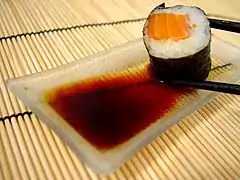 Salmon roll (巻き鮭)
Salmon roll (巻き鮭) Kakinoha (柿の葉寿司, persimmon leaf) sushi
Kakinoha (柿の葉寿司, persimmon leaf) sushi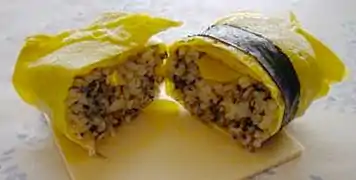 Chakin-zushi (茶巾寿司), wrapped in thin omelette
Chakin-zushi (茶巾寿司), wrapped in thin omelette.jpg.webp) Sushi plate (盛り合わせ)
Sushi plate (盛り合わせ).jpeg.webp) Ikura gunkan-maki (イクラ軍艦巻き)
Ikura gunkan-maki (イクラ軍艦巻き)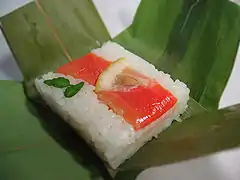 Sasa (笹寿司, bamboo leaf) sushi
Sasa (笹寿司, bamboo leaf) sushi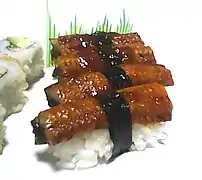 Unagi (鰻寿司, teriyaki-roasted freshwater eel) sushi
Unagi (鰻寿司, teriyaki-roasted freshwater eel) sushi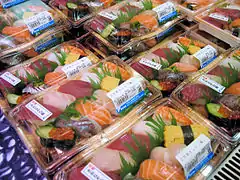 Nigirizushi for sale at a supermarket in Tokyo
Nigirizushi for sale at a supermarket in Tokyo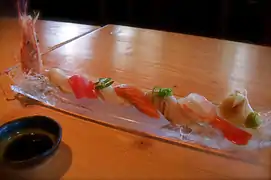 Assorted sushi (盛り合わせ)
Assorted sushi (盛り合わせ).jpg.webp) Assorted Western sushi (盛り合わせ)
Assorted Western sushi (盛り合わせ)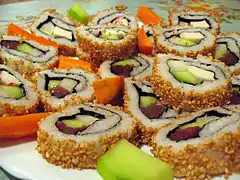 Western California roll and tuna roll uramaki (カリフォルニア巻き)
Western California roll and tuna roll uramaki (カリフォルニア巻き)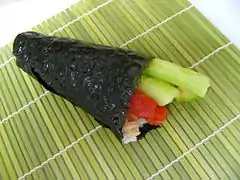 Western spicy tuna hand roll (スパイシーツナロール)
Western spicy tuna hand roll (スパイシーツナロール)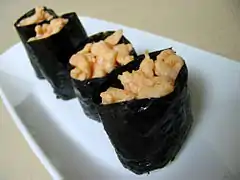 Western spicy shrimp roll (スパイシー海老ロール)
Western spicy shrimp roll (スパイシー海老ロール).jpg.webp) Gari (ginger)
Gari (ginger)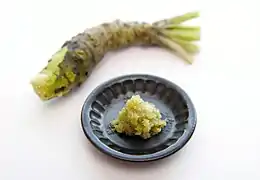 Wasabi
Wasabi_(3313677892).jpg.webp) Tamago sushi
Tamago sushi
See also
- Burong isda, Filipino fermented fish and rice similar to narezushi
- Gimbap, Korean variant of makizushi
- Customs and etiquette in Japanese dining
- List of sushi and sashimi ingredients
- List of sushi restaurants
- Pla ra, Thai fermented fish and rice similar to narezushi
- Nyotaimori, sushi presented on nude female body
- Sashimi bōchō, Japanese knife to slice raw fish and seafood
- Spam musubi, Hawaiian variant of nigirizushi
- Sushi machine
References
- "Sushi - How-To". FineCooking. 1998-05-01. Archived from the original on 2019-11-04. Retrieved 2019-11-04.
- "The Mysteries of Sushi - Part 2: Fast Food". Toyo Keizai. 23 May 2015. Archived from the original on 9 September 2017.
- "When Sushi Became a New Fast Food in Edo". Nippon.com. 22 December 2020. Archived from the original on 18 January 2021.
- "Sushi". Nihonbashi. Archived from the original on 28 December 2021.
- "Sashimi vs Sushi – Difference and Comparison | Diffen". www.diffen.com. Archived from the original on 2019-06-05. Retrieved 2019-06-05.
- Lee, Cherl-Ho; Steinkraus, Keith H; Reilly, P.J. Alan (1993). Fish fermentation technology. Tokyo: United Nation University Press. OCLC 395550059. Archived from the original on 2021-01-13. Retrieved 2021-06-17.
- Hill, Amelia (2007-10-08). "Chopsticks at dawn for a sushi showdown". The Guardian. London. Archived from the original on 2007-12-17. Retrieved 25 September 2011.
- 1988, 国語大辞典(新装版) (Kokugo Dai Jiten, Revised Edition) (in Japanese), Tōkyō: Shogakukan
- Kouji Itou; Shinsuke Kobayashi; Tooru Ooizumi; Yoshiaki Akahane (2006). "Changes of proximate composition and extractive components in narezushi, a fermented mackerel product, during processing". Fisheries Science. 72 (6): 1269–1276. doi:10.1111/j.1444-2906.2006.01285.x. S2CID 24004124.
- Bestor, Theodore C. (2004-07-13). Tsukiji: The Fish Market at the Center of the World. p. 141. ISBN 9780520923584.
- Lowry, Dave (2010). The Connoisseur's Guide to Sushi. ReadHowYouWant.com. p. xvii. ISBN 978-1458764140. Archived from the original on 2021-06-17. Retrieved 2020-11-01.
A nugget of rice was seasoned with vinegar and topped by a sliver of seafood fresh from the bay that was only a few blocks away. That is why a synonym for nigiri sushi is Edomae sushi: Edomae is "in front of Edo", i.e., the bay.
- Mouritsen, Ole G. (2009). Sushi: Food for the Eye, the Body and the Soul. Springer. p. 17. ISBN 978-1441906182. Archived from the original on 2021-06-17. Retrieved 2020-11-01.
Edomae-zushi or nigiri-zushi? Nigiri-zushi is also known as Edomae-zushi. Edomae refers to the small bay in Edo in front of the old palace that stood on the same site as the present-day imperial precinct in Tokyo. Fresh fish and shellfish caught in the bay were used locally to make sushi, which was known as Edomae-zushi. It has, however, been many years since these waters have been a source of seafood. Now the expression Edomae-zushi is employed as a synonym for high quality nigiri-zushi.
- "Sushi", Oxford English Dictionary, Second edition, 1989; online version December 2011. Accessed 23 December 2011.
- Bacon, Alice Mabel (1893). A Japanese interior. Houghton, Mifflin and Company. p. 271.
p. 271: "Sushi, a roll of cold rice with fish, sea-weed, or some other flavoring" p. 181: "While we were waiting for my lord and my lady to appear, domestics served us with tea and sushi or rice sandwiches, and the year-old baby was brought in and exhibited." p. 180: "All the sushi that I had been unable to eat were sent out to my kuruma, neatly done up in white paper."
- James Curtis Hepburn, Japanese–English and English–Japanese dictionary, Publisher: Randolph, 1873, 536 pages ( page 262)
- W. H. Patterson, Japanese Cookery, "Notes and queries", Publisher: Oxford University Press, 1879. (p.263 Archived 2016-02-02 at the Wayback Machine)
- Kawasumi, Ken (2001). The Encyclopedia of Sushi Rolls. Graph-Sha. ISBN 978-4-88996-076-1.
- Adimando, Stacy (2019-03-18). "Chirashi is Sushi for the Rest of Us". Saveur. Retrieved 2022-10-24.
- Smyers, Karen Ann. The Fox and the Jewel: Shared and Private Meanings in Contemporary Japanese Inari Worship(1999), Honolulu: University of Hawaii Press, p. 96.
- Ann Kondo Corum, Ethnic Foods of Hawaii (2000). Bess Press: p. 54.
- Betty Shimabukuro, "Yama's Fish Market offers more than fish Archived 2012-05-13 at the Wayback Machine (March 20, 2002). Honolulu Star-Bulletin.
- Joan Namkoong, Go Home, Cook Rice: A Guide to Buying and Cooking the Fresh Foods of Hawaii (2001). Ness Press: p. 8.
- Joan Namkoong, Food Lover's Guide to Honolulu (2006), Bess Press, p. 37.
- Ōmae, Kinjirō; Tachibana, Yuzuru (1988). The book of sushi (1st paperback ed.). Tokyo: Kōdansha International. p. 70. ISBN 9780870118661. OCLC 18925025.
- Strada, Judi; Moreno, Mineko Takane (2004). Sushi for dummies. John Wiley & Sons. p. 106. ISBN 978-0-7645-4465-1. Archived from the original on 2020-08-19. Retrieved 2019-01-09.
Sliced sushi rolls are traditionally made in three different sizes, or diameters: thin 1-inch rolls (hoso-maki); medium 11⁄2-inch rolls (chu-maki); and thick 2 to 2+1⁄2-inch rolls (futo-maki)."
- "Setsubun [節分]". Heisei Nippon seikatsu benrichō [平成ニッポン生活便利帳] (in Japanese). Tokyo: Jiyū Kokuminsha. 2012. Archived from the original on August 25, 2007. Retrieved 2012-05-26.
- "Ehō-maki". Dijitaru daijisen (in Japanese). Tokyo: Shogakukan. 2012. Archived from the original on August 25, 2007. Retrieved 2012-05-26.
- "Setsubun Ehomaki, Mame-maki and Grilled Sardine". Kyoto Foodie. 5 February 2009. Archived from the original on 2014-08-07. Retrieved 2015-01-22.
- Andy Bellin (March 2005). "Poker Night in Napa". Food & Wine. Archived from the original on 2012-04-06. Retrieved 2007-06-28.
- Ryuichi Yoshii, "Tuna rolls (Tekkamaki)" Archived 2016-05-13 at the Wayback Machine, Sushi, p. 48 (1999), Tuttle Publishing, ISBN 962-593-460-X.
- "Packaging For Temaki Sushi". Gpe.dk. Archived from the original on 2012-04-25. Retrieved 2012-11-07.
- Hosking, Richard (1997). A Dictionary of Japanese Food: Ingredients & Culture. Tuttle Publishing. p. 222. ISBN 978-0-8048-2042-4. Archived from the original on 2020-08-18. Retrieved 2015-12-20.
- Steinkraus, Keith H. (1993). Comparison of Fermented Foods of the East and West. Fish Fermentation Technology. United Nations University Press. p. 132. ISBN 9788970530031. Archived from the original on 2020-08-19. Retrieved 2018-03-16.: "still being produced prototypical form.. around Lake Biwa".
- Hosking, Richard (1998), "From Lake and Sea. Goldfish and Mantis Shrimp Sushi", Fish: Food from the Waters, Oxford Symposium, pp. 160–161, ISBN 978-0-9073-2589-5, archived from the original on 2021-01-10, retrieved 2018-03-16
- Chad Hershler (May 2005). "Sushi Then and Now". The Walrus. Archived from the original on 2010-01-14.
- (ja) 軍カン巻の由来, お寿し大辞典 > お寿し用語集, 小僧寿しチェーン.
- Ashkenazi, Michael; Jacob, Jeanne (2000). The essence of Japanese cuisine: an essay on food and culture. University of Pennsylvania Press. p. 231. ISBN 978-0-8122-3566-1. Archived from the original on 2021-06-17. Retrieved 2020-10-16.
Called saba zushi or battera, after the Portuguese term for "small boat", which the mould resembles.
- "Osaka Style Boxed Sushi". Sushi Encyclopedia. Archived from the original on January 16, 2008.
- Jiang, Jess (18 September 2015). "How the Desperate Norwegian Salmon Industry Created a Sushi Staple". Planet Money (blog/podcast). All Things Considered. NPR. Archived from the original on 24 April 2019. Retrieved 19 September 2015.
- "Episode 651: The Salmon Taboo". NPR.org. Archived from the original on 2021-04-17. Retrieved 2021-04-17.
- "How The Desperate Norwegian Salmon Industry Created A Sushi Staple". NPR.org. Archived from the original on 2019-04-24. Retrieved 2021-04-17.
- Matsui, Akira (2005-06-01). "Salmon Exploitation in Jomon Archaeology from a Wetlands Point of View". Journal of Wetland Archaeology. 5 (1): 49–63. doi:10.1179/jwa.2005.5.1.49. ISSN 1473-2971. S2CID 140720425. Archived from the original on 2021-06-17. Retrieved 2021-04-17.
- Sollesnes, Oeystein (March 10, 2018). "The Norwegian campaign behind Japan's love of salmon sushi". The Japan Times. Archived from the original on January 9, 2019. Retrieved January 9, 2019.
- Norway Exports (8 April 2011). "Norway's Introduction of Salmon Sushi to Japan". Nortrade. Archived from the original on 28 January 2017. Retrieved 19 September 2015.
- "Norway Roll of Umegaoka Sushi No Midori Sohonten Shibuya". Archived from the original on 2016-08-06. Retrieved 2016-05-09.
- "Sushi Pioneers". SushiMasters. Archived from the original on 2013-04-11. Retrieved 2008-07-26.
- "Tradição X modernidade na comida japonesa | O TEMPO". www.otempo.com.br. Archived from the original on 2021-06-17. Retrieved 2021-06-17.
- Julia Moskin (April 8, 2004). "Sushi Fresh From the Deep. .. the Deep Freeze". New York Times. Archived from the original on 2014-01-06. Retrieved 2013-12-23.
Most would be even more surprised to learn that if the sushi has not been frozen, it is illegal to serve it in the United States. Food and Drug Administration regulations stipulate that fish to be eaten raw – whether as sushi, sashimi, seviche, or tartare – must be frozen first, to kill parasites.
- "Alaska Roll". Sushi Sama. Archived from the original on 18 December 2013. Retrieved 11 December 2013.
- "Boston Roll Recipe". Sushi Encyclopedia. Archived from the original on 9 October 2014. Retrieved 15 October 2014.
- "What is a BC Roll?". The Sushi Index. Archived from the original on 11 December 2014. Retrieved 11 December 2013.
- "California Roll". Sushi Sama. Archived from the original on 18 December 2013. Retrieved 11 December 2013.
- "Dynamite Roll Recipe". Japanese Sushi Recipes. Archived from the original on 13 July 2013. Retrieved 11 December 2013.
- Frisch, Eleanor. "Japanese and Western Types of Sushi". Food Service Warehouse. Archived from the original on 15 November 2013. Retrieved 11 December 2013.
- De Laurentiis, Giada. "Crab, Avocado and Mango Roll". Food Network. Archived from the original on 19 December 2013. Retrieved 11 December 2013.
- "Michigan Roll Recipe". The Sushi Encyclopedia. Archived from the original on 17 January 2014. Retrieved 11 December 2013.
- Romero, David (2015-07-13). "Green chile prominently featured in sushi roll". KRQE. Archived from the original on 2016-05-06. Retrieved 16 May 2016.
- Garduño, Gil (2011-10-29). "I Love Sushi – Albuquerque, New Mexico". Gil's Thrilling (And Filling) Blog. Archived from the original on 2016-06-10. Retrieved 16 May 2016.
- "Sushi order form". Japanese Kitchen Albuquerque. Archived from the original on 1 February 2016. Retrieved 16 May 2016.
- "Sushi order form". Nagomi Restaurant ABQ. Archived from the original on 2 May 2016. Retrieved 16 May 2016.
- "Philadelphia Roll Recipe". Sushi Encyclopedia. Archived from the original on 28 October 2016. Retrieved 11 December 2013.
- "Rainbow Roll Recipe". Sushi Encyclopedia. Archived from the original on 27 June 2013. Retrieved 11 December 2013.
- "Spicy Seattle Tuna Rolls". Bon Appetit. 12 July 2011. Archived from the original on 7 March 2014. Retrieved 11 December 2013.
- Moonen, Rick. "Spider Roll". Food Network. Archived from the original on 17 November 2013. Retrieved 11 December 2013.
- Kearns, Landess (2015-06-19). "Sushi Burritos Prove You Really Can Have It All". Huffington Post. Archived from the original on 2017-06-27. Retrieved 14 May 2017.
- Peyton, Gabby (16 March 2017). "10 questionable things Canada has done to sushi". DailyHIve. Retrieved 3 Nov 2021.
{{cite web}}: CS1 maint: url-status (link) - Staff, DH Montreal (2 March 2017). "You have to try this insane Montreal sushi dish". DailyHIve. Retrieved 3 Nov 2021.
{{cite web}}: CS1 maint: url-status (link) - William-Ross, Lindsay (10 March 2017). "Where to have your Sushi Cake...and eat it, too". DailyHIve. Retrieved 3 Nov 2021.
{{cite web}}: CS1 maint: url-status (link) - Chowhound (11 July 2008). "Sushi Pizza- California specialty?! - General Discussion - Sushi". Chowhound. Retrieved 3 Nov 2021.
{{cite web}}: CS1 maint: url-status (link) - Bill Esparza (August 1, 2013), "Oh No, There Goes Tokyo Roll—Sinaloa Style Sushi Invades Los Angeles", Los Angeles Magazine
- Alexander, Stian (21 January 2016). "UK's new favourite takeaway has been revealed - and it's not what you'd think". Daily Mirror. Archived from the original on 26 September 2018. Retrieved 26 February 2017.
- Cho, Joy (3 January 2021). "Kimbap: Colorful Korean rolls fit for a picnic". Salon. Retrieved 30 July 2021.
- Shimbo, Hiroko (2000-11-08). The Japanese Kitchen: 250 Recipes in a Traditional Spirit. Harvard Common Press. p. 128. ISBN 9781558321779. Archived from the original on 2021-06-17. Retrieved 2020-10-16.
Unlike wakame, kombu, and hijiki, which are sold in the form of individual leaves, nori is sold as a sheet made from small, soft, dark brown algae, which have been cultivated in bays and lagoons since the middle of the Edo Era (1600 to 1868). The technique of drying the collected algae on wooden frames was borrowed from famous Japanese paper-making industry.
- Pallett, Steven (2004). Simply sushi. Hinkler Books. p. 289. ISBN 9781741219722. Archived from the original on 2021-06-17. Retrieved 2020-10-16.
- Lowry, Dave (2005). The Connoisseur's Guide to Sushi: Everything You Need to Know about Sushi Varieties and Accompaniments, Etiquette and Dining Tips, and More. Harvard Common Press. ISBN 9781558323070. Archived from the original on 2021-06-17. Retrieved 2020-10-16.
- Smith, Andrew F. (2012-08-08). American Tuna: The Rise and Fall of an Improbable Food. University of California Press. p. 95. ISBN 9780520261846.
{{cite book}}:|access-date=requires|url=(help) - Archived url, live status. - Orwig, Rob Ludacer, Jessica. "Here's what imitation crab meat is really made of". Business Insider. Archived from the original on 2019-06-05. Retrieved 2019-06-05.
- Sakagami, Nick (2019-06-04). Sushi Master: An expert guide to sourcing, making and enjoying sushi at home. Quarry Books. p. 87. ISBN 9781631596735. Archived from the original on 2021-06-17. Retrieved 2020-10-16.
- Shimbo, Hiroko (2000). The Japanese Kitchen. Harvard Common Press. ISBN 978-1-55832-176-2.
- Shin, I. S.; Masuda H.; Naohide K. (August 2004). "Bactericidal activity of wasabi (Wasabia japonica) against Helicobacter pylori". International Journal of Food Microbiology. 94 (3): 255–61. doi:10.1016/S0168-1605(03)00297-6. PMID 15246236.
- Gordenker, Alice (2008-01-15). "Bento grass". The Japan Times Online. ISSN 0447-5763. Archived from the original on 2015-12-10. Retrieved 2015-12-08.
- "Culinary Curiosities: That plastic leaf in sushi". CNN. June 21, 2010. Archived from the original on September 26, 2013. Retrieved September 22, 2013.
- Lee, Bruce Y. "Eating Fish, Sleep, And Smarts: Here's What The Study Really Said". Forbes. Archived from the original on 2018-01-19. Retrieved 2018-01-18.
- MSc, Sylvie Tremblay. "Is Eating Sushi Healthy? Plus the Best & Worst Sushi to Order". LIVESTRONG.COM. Archived from the original on 2018-01-19. Retrieved 2018-01-18.
- "Sushi Calories and Nutritional Information". The Sushi FAQ. Archived from the original on 2018-01-19. Retrieved 2018-01-18.
- "Methylmercury: What You Need to Know About Mercury in Fish and Shellfish". Food and Drug Administration. 2004-03-01. Archived from the original on 2013-03-17. Retrieved 2012-09-18.
- González, N; Correig, E; Marmelo, I; Marques, A; la Cour, R; Sloth, JJ; Nadal, M; Marquès, M; Domingo, JL (July 2021). "Dietary exposure to potentially toxic elements through sushi consumption in Catalonia, Spain". Food and Chemical Toxicology. 153: 112285. doi:10.1016/j.fct.2021.112285. PMID 34023460. S2CID 235168607.
- Jones, J.L.; Anderson, B.; Schulkin, J.; Parise, M. E.; Eberhard, M. L. (2011-03-01). "Sushi in Pregnancy, Parasitic Diseases – Obstetrician Survey". Zoonoses and Public Health. 58 (2): 119–125. doi:10.1111/j.1863-2378.2009.01310.x. ISSN 1863-2378. PMID 20042060. S2CID 38590733. Archived from the original on 2020-11-06. Retrieved 2019-09-13.
- "Clonorchis sinensis – Material Safety Data Sheets (MSDS)". Public Health Agency of Canada. 2011-02-18. Archived from the original on 2012-09-14. Retrieved 2012-09-18.
- "Parasites – Anisakiasis". Centers for Disease Control and Prevention. 2010-11-02. Archived from the original on 2012-09-25. Retrieved 2012-09-18.
- Dugdale, DC (2011-08-24). "Fish tapeworm". MedlinePlus. Archived from the original on 2016-07-04. Retrieved 2012-09-18.
- European Parliament (2004-04-30). "Regulation (EC) No 853/2004 of The European Parliament and of the Council of 29 April 2004 laying down specific hygiene rules for on the hygiene of foodstuffs" (PDF). Official Journal of the European Union. 139 (55): 133. Archived from the original on 2012-04-20. Retrieved 2010-07-09.
- Issenberg, Sasha (2008). The sushi economy: globalization and the making of a modern delicacy. New York: Gotham. ISBN 978-1592403639.
- Macfarlane, Alex. "The Truth About Sushi Fish". Everything Sushi Blog Interview. Archived from the original on 24 April 2013. Retrieved 3 December 2012.
- Pappalardo, AM; Raffa, A; Calogero, GS; Ferrito, V (2 April 2021). "Geographic Pattern of Sushi Product Misdescription in Italy-A Crosstalk between Citizen Science and DNA Barcoding". Foods (Basel, Switzerland). 10 (4): 756. doi:10.3390/foods10040756. PMC 8066630. PMID 33918119.
- Warin, Rosemary H.; Steventon, Glyn B.; Mitchell, Steve C. (2007). Molecules of death. Imperial College Press. p. 390. ISBN 978-1-86094-814-5. Archived from the original on 2021-06-17. Retrieved 2020-10-16.
- "One Man's Fugu Is Another's Poison". The New York Times. 1981-11-29. Archived from the original on 2012-01-25. Retrieved 2011-02-26.
- "System and method for identification and tracking of food items" (PDF). U.S.Patent Office. Archived (PDF) from the original on 2019-02-23. Retrieved 2019-02-23.
- Bindel, Julie (12 February 2010). "'I am about to eat sushi off a naked woman's body'". The Guardian. Archived from the original on 21 July 2020. Retrieved 20 August 2020.
- Danovich, Tove (23 October 2017). "Is Naked Sushi All About the Nigiri or the Nudity?". VICE. Archived from the original on 17 July 2020. Retrieved 20 August 2020.
- Lin, Eddie (18 April 2007). "Selling the Sizzle Even Though It's Sushi". The New York Times. Archived from the original on 9 November 2020. Retrieved 20 August 2020.
- (in Japanese) Osushiyasan no arukikata お寿司屋さんの歩き方 Archived 2012-02-29 at the Wayback Machine, Retrieved February 2012.
- (in Japanese) 'Ojisan, oaiso' tsuihō undō 「おじさん、おあいそ」追放運動 Archived 2012-05-09 at the Wayback Machine, Retrieved February 2012.
- "Japanese Meaning of 煮詰める, 煮つめる, につめる, nitsumeru". Nihongo Master. Archived from the original on 2020-02-04. Retrieved 2020-02-04.
- Issenberg, Sasha. The Sushi Economy. Gotham Books: 2007
- Honey, Kim (March 18, 2009). "Are you sushi savvy?". Toronto Star. Archived from the original on 2009-03-23. Retrieved 2009-11-09.
- Lowry, Dave (2005). The Connoisseur's Guide to Sushi. Harvard Common Press. p. 273. ISBN 978-1-55832-307-0.
Further reading
- Joro Ono, Masuhiro Yamamoto (2014). 鮨 すきやばし次郎: JIRO GASTRONOMY (in Japanese). Shogakukan. ISBN 978-4093883856.
- Joro Ono, Masuhiro Yamamoto (2016). 匠 すきやばし次郎: JIRO PHILOSOPHY (in Japanese). Shogakukan. ISBN 978-4093884976.
- Mitshuhiro Araki, Chieko Asazuma (2004). 江戸前「握り」 (in Japanese). Kobunsha. ISBN 978-4334032319.

